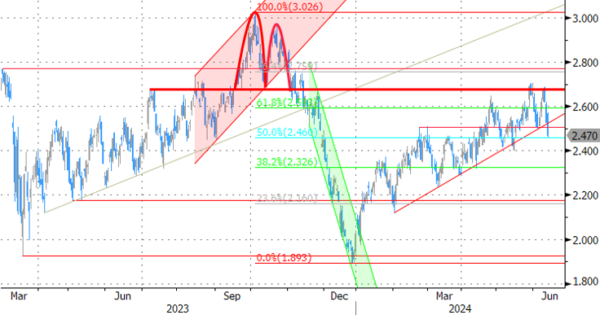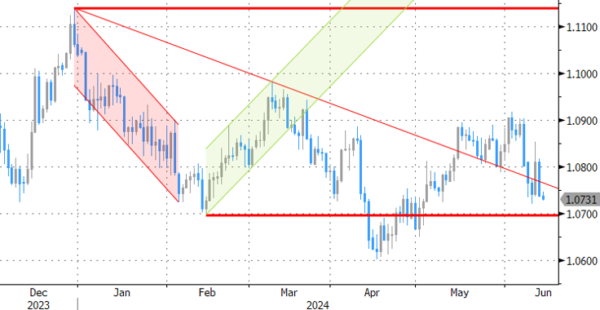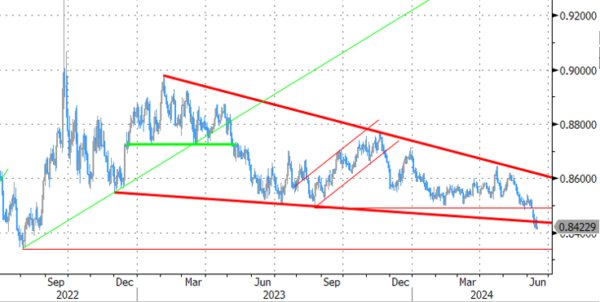Markets
Core bond yields stumbled yesterday. US yields dropped between 5.5 (2-yr) and 7.8 bps (30-yr) on a combination of slower than expected PPI numbers (negative even in the headline reading), a jump in weekly jobless claims to the highest in nine months (242k) and a $22bn 30-yr auction that stopped through (4.403% vs 4.418% WI) and attracted solid investor demand. The US 2-yr tested the post-Fed low but prevented a break/close below for the time being. The 10-yr hit the lower bound of a downward sloping trend channel in place since end April. German yields slipped 4.7 (30-yr) to 8.2 (2-yr) bps. The move was inspired by the US as well as the result of lingering European/French political uncertainty with another round of disastrous polls for Macron’s group hitting the wires. The French president reiterated he plans to stay in power until 2027. But it appears that the more he does so, the less markets believe him. The 10-yr OAT/swapspread jumped to the highest level since early 2014 and is trading a mere 2 bps below Portugal’s. European stock markets tanked about 2%, contrasting with the S&P500 and Nasdaq in the US extending their record run. The euro didn’t escape the sharp European repricing and slid from EUR/USD 1.0809 at the open to 1.0737. The common currency hit a new YtD low against sterling with EUR/GBP closing at 0.8413, the weakest level since August 2022. The Swiss franc banked on its safe haven status. EUR/CHF eased to 0.959 as a weak euro is now taking over from/complementing a SNB-powered CHF. USD/JPY finished only slightly higher yesterday as both a strong US dollar and JPY against the risk-off background kept each other in check. That changed this morning though with the pair nearing the April JPY-intervention levels in the wake of the BoJ policy meeting (cfr. infra). The remaining eco calendar contains US consumer sentiment (Michigan University), which is unlikely to leave a material mark on markets. US bond yields currently recover some ground by adding less than 3 bps across the curve. We continue to err on the side of caution going into the weekend though, especially for Europe. Reports of the 2025 budget stand-off pushing the German government to the brink are obviously not helping in the current environment. The ruling coalition also got a beating in the European elections while the far-right gained. The vote is seen as a gauge for next year’s federal elections in Germany. In case of renewed risk aversion, first support in the German 10-yr yield pops up at 2.4%. If EUR/USD 1.0695/1.0712 breaks, there’s little in the way for a return towards 1.06.
News & Views
The Bank of Japan kept its policy target range unchanged at 0%-0.1% this morning as expected. The central bank will continue conducting bond purchases as set out on March until the next, July, meeting. The BoJ also decided in a 8-1 majority vote that it would reduce its purchase amount of JGB’s to ensure that long-term interest rates would be formed more freely in financial markets. At the July meeting, a detailed taper plan will be communicated. In order not to shock markets, the process will last one to two years. Japan’s economy is likely to keep growing at a pace above its potential growth rate. Simultaneously, the year-on-year rate of increase in the CPI is projected to be pushed up through fiscal 2025 by factors such as a waning of the effects of fiscal measures. Underlying CPI is expected to gradually increase as the output gap improves and medium- to long-term inflation expectations rise with a virtuous cycle between wages and prices continuing to intensify. BoJ governor Ueda will still hold a press conference at 8:30 am CET. The Japanese yen already faces renewed selling pressure because of the ultra-cautious policy normalization process of the BoJ. USD/JPY hits 158 for the first time since end-of-April FX interventions.
Czech National Bank governor Michl in a speech yesterday set out his strategy for the next CNB meetings. The debate at the next meeting at the end of June will probably be about whether to cut by 50 or by 25 bps (currently 5.25%). Both options are open, and in both cases, the CNB will still be in restrictive territory. Then they will be very cautious about further rate cuts. They will assess new data at each meeting and decide accordingly. The rate cutting process can be paused or stopped at any time if inflation, especially core inflation, is not in line with their forecast. The CNB will stay hawkish and do everything in its power to achieve long-term price stability and not trigger inflation. The closer they get to neutral (current estimate 3%-3.5%), the more likely that they’ll slow down or even interrupt policy normalization.
Graphs
GE 10y yield
The ECB cut its key policy rates by 25 bps at the June policy meeting. A more bumpy inflation path in H2 2024, the EMU economy gradually regaining traction and the Fed’s higher for longer US strategy make follow-up moves difficult. Markets are coming to terms with that. For the time being, though, the political narrative dominates. After hitting a new YtD top at 2.7%, the German 10-yr yield corrected lower on safe haven bids.
US 10y yield
The Fed is seeking more evidence than just one slower-than-expected (May) CPI is providing. Upgraded inflation forecasts and a higher neutral rate complicate the exact timing of a first cut further. June dots suggest one move in 2024 followed by four more next year. Markets are positioned more aggressively, turning the recent low in yields into a technical support zone. The US 10-y yield remains stuck in the 4.3/4.7% trading range.
EUR/USD
EUR/USD is trapped in the 1.06-1.09 range. The desynchronized rate cut cycle with the ECB exceptionally taking the lead, strong US May payrolls and a swing to the right in European elections pulled the pair away from 1.09 resistance. The Fed meeting balanced the weaker than expected US CPI outcome. Euro fragility makes a return to the 1.06 downside more likely than not.
EUR/GBP
Debate at the Bank of England is focused at the timing of rate cuts. Slower than expected April disinflation and a surprise general election on July 4 suggest that a June cut in line with the ECB looks improbable. Sterling gained momentum with money markets now discounting a Fed-like scenario. EUR/GBP tested the 2023 & 2024 lows near 0.85. Euro weakness eventually pulled the trick after French president Macron called snap elections following a weak showing in EU elections.

















